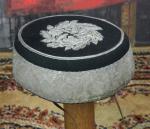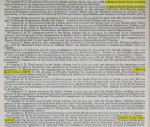-
Posts
1,761 -
Joined
-
Last visited
-
Days Won
3
Content Type
Profiles
Forums
Blogs
Gallery
Events
Store
Everything posted by Stuart Bates
-

Silver Lace
Stuart Bates replied to Stuart Bates's topic in Preservation & Restoration of Military Artifacts
Hi Peter, depending on the condition of the lace, and I have only that photo to go by, I will try the cream of tartar method as it is contemporary with the cap itself. I have another cap, gold lace, in very poor condition that I would try any solution (intended) on before tackling the Worcester pillbox. cheers, Stuart -

Silver Lace
Stuart Bates replied to Stuart Bates's topic in Preservation & Restoration of Military Artifacts
Hi Elvis, yes that is crystal clear and thanks again. Stuart -
Mervyn, the cap is attributed to Major John Henry Crane of Oakhampton House, Dunley. He was commissioned in 1885, promoted Captain in 1894 and was still a Captain in 1900. He served in the Boer War as a Major, 31st Dec. 1901, in the Imperial Yeomanry (Queen's Own Worcester Hussars) 1901 - 1904. The Worcester Yeomanry wore this style of cap from 1871 to about 1900. I have a photo which shows a group of officers wearing it and dated 1893 and another showing them all wearing the folding field service cap and dated 1897. So I would guess that this example dates from 1885 to mid 1890s. As a side note "During the Boer War, while her husband was away on active service, Mrs Crane converted to Roman Catholicism, built a chapel in the grounds of the park and installed a live-in priest. On his return, Maj Crane had the chapel demolished, the priest thrown out and his marriage dissolved. He died at Oakhampton in 1932." Stuart
-

Silver Lace
Stuart Bates replied to Stuart Bates's topic in Preservation & Restoration of Military Artifacts
Hi Elvis, Is REAL-LEATHER a product? I suppose I should have googled it first. I haven't received the cap yet but attach a photo from the seller. The lace looks a bit grubby so I thought I would enquire of the forum members before it arrived. Thanks, Stuart -
I just purchased a pillbox cap with silver lace band which looks like it could do with a little cleaning. The 1900 Dress Regulations state that gold lace "which has become slightly tarnished can be cleaned with a mixture of Cream of Tartar and bread rubbed up very fine, applied in a dry state and brushed lightly with a clean soft brush." Where is my batman when I need him I have read Cream of Tartar (Potassium bitartrate) can be used with white vinegar to make a paste-like cleaning agent. Obviously I don't want to ruin the cap so any advice greatly appreciated. Stuart
-
I have only had good experiences with packages, at least ones that were not damaged. If a package is delivered in a damaged state I always photograph it in front of the courier and then open it. Around here our mail is delivered by an Australia Post contract courier so you quickly get to know them. I guess that the only problem I have had is when a package got to the main Post Office in my area, then got shipped about 200 kms further West before being returned to Sydney. A complete cock up. Stuart
-

german ?
Stuart Bates replied to blueman's topic in Germany: Imperial Uniforms, Headwear, Insignia & Personal Equipment
Sorry Kev, but the only thing that makes it rare is the German plate on a British helmet. The plate may be worth something, that is not my area, but the helmet no. It looks like someone has applied some sort of sealant around the dome base to secure it. BTW: how did the auctioneers describe it? Regards, Stuart www.militarysunhelmets.com -

german ?
Stuart Bates replied to blueman's topic in Germany: Imperial Uniforms, Headwear, Insignia & Personal Equipment
Kev, the helmet and other items have what appears to be auction labels attached. Are you selling? As you indicated with the others posted, headgear was not your thing? Stuart BTW: who are the auctioneers? Are! I see it is Sworders Fine Art Auctioneers -

german ?
Stuart Bates replied to blueman's topic in Germany: Imperial Uniforms, Headwear, Insignia & Personal Equipment
I agree with Naxos the helmet would appear to be a British Wolseley. And it looks like the crown has been crushed badly. There seems to be a bit of "repair" around the dome of the spike. How many ventilation holes does that dome base have? Looks like a bit of a "marriage" helmet. Stuart -

Royal Horse Artillery!
Stuart Bates replied to st helena's topic in Great Britain: Militaria: Badges, Uniforms & Equipment
-

Royal Horse Artillery!
Stuart Bates replied to st helena's topic in Great Britain: Militaria: Badges, Uniforms & Equipment
I did some checking in a few Army lists and came up with this - Army List of 1900 RHA J Battery, Bangalore. Major —J. M. S. Brunker. Captain —H. Corbyn. Lieuts.— V. R. Hine-Kaycock. W. P. Monk house. L. H. D. Broughton. Army List 1901 and 1902 J. Battery - S. Africa Major Ducrot, L.H. Captain Sykes, C.A. Lieuts. Hill, H.W. Clark, W.E. Hartland-Mahon, M.C.J. -

Africa and Italy Star
Stuart Bates replied to Weseruebung's topic in Great Britain: Orders, Gallantry, Campaign Medals
Dan, thanks, so my Father's is the right way round. As to the value, well they are my heritage so no possibility of selling them, but perhaps this was directed at Chris. Stuart -

duke of lancaster ?
Stuart Bates replied to blueman's topic in Great Britain: Militaria: Badges, Uniforms & Equipment
Kev, do you own the helmet or are you thinking of buying it? I guess the same question applies to the other two that you posted. Just interested. Stuart -

Africa and Italy Star
Stuart Bates replied to Weseruebung's topic in Great Britain: Orders, Gallantry, Campaign Medals
I looked at my Dad's medal group which includes the Africa Star and the clasp reads "8TH ARMY." The ribbon is the opposite way round on my Dad's with the light blue stripe being on the right as one views it. Which is correct? Stuart -

duke of lancaster ?
Stuart Bates replied to blueman's topic in Great Britain: Militaria: Badges, Uniforms & Equipment
Dan, the one you posted is of metal construction. I was a little amazed that the narrative described the large dent as possibly being from a sword cut. A sword would have gone through these helmets as they were not that substantial. It seems that leather helmets were worn by ORs from 1857 to 1865 max. That is a good site which you located. I have never heard of it but as I am reduced to postal bids and am therefore on a hiding-to-nothing I just don't bother. Still get Bosley's catalogues though as they are a useful reference. Cheers, Stuart -

duke of lancaster ?
Stuart Bates replied to blueman's topic in Great Britain: Militaria: Badges, Uniforms & Equipment
-

duke of lancaster ?
Stuart Bates replied to blueman's topic in Great Britain: Militaria: Badges, Uniforms & Equipment
Dan, that is the helmet but I think the chinchain and rosettes are a later addition. They look to be from a Life or Horse Guards helmet. A tailor's pattern book of 1859 states that "Helmet: Same as Staffordshire Yeomanry; gilt ornaments." In a little booklet I have the authors state that in 1857 the helmet was issued to the ORs and was of black japanned leather. They also say that the officers had metal helmets and that by 1865 all ranks had metal helmets. The Staffordshire helmet, of which I have an example, has foliage on both the front and back peak as well as around the base of the helmet and the backstrap. Kev, It is hard to know what to make of your example. There seems to be some damage to the helmet shell around the top of the crown and this could indicate a different helmet plate was previously fitted. With the plume, plume holder and its base all being wrong and the lack of any ornamental foliage I would not touch it. Stuart -

duke of lancaster ?
Stuart Bates replied to blueman's topic in Great Britain: Militaria: Badges, Uniforms & Equipment
Is the helmet metal or leather? Stuart -

Royal Horse Artillery!
Stuart Bates replied to st helena's topic in Great Britain: Militaria: Badges, Uniforms & Equipment
Here is an illustration of an RHA captain c1897. There are plenty of books on the RHA and Dress Regulations are readily available from Naval & Military Press and D, P & G Publishing. I have all of the DRs and I suspect the ones you require are 1891, 1894, 1900, 1904 and maybe 1911. The latter two are in CD format or downloadable from www.youroldbooksandmaps.co.uk. You may also need some Army Lists for the period and they are also available from youroldbooksandmaps as well as others. Kipling & King are generally regarded as the bible for headgear badges and their book is also readily available. Another few are - Uniforms of the Royal Artillery by P.H. Smitherman The History of the Dress of the Royal Regiment of Artillery by Captain R.J. MacDonald Uniforms of the British Army: The Cavalry Regiments by W.Y. Carman Stuart PS. I find www.bookfinder.com very useful for locating books worldwide -

duke of lancaster ?
Stuart Bates replied to blueman's topic in Great Britain: Militaria: Badges, Uniforms & Equipment
Well the helmet plate looks like the Duke of Lancaster's but the rest of the helmet... the plume holder base looks like a homemade job as the real deal had an Acanthus leaf base and plume holderI cannot make out the plume holder but sufficient to say that it is not correctthe plume itself was white and not redthere was a floriate metal band, in gilding metal, running around the helmet front to rearthere was also a floriate backstrap The example that I have seen has voiding around the floriate sprays of the helmet plate but this one could be an Other Rank's version, assuming that the HPs were different. Stuart -

Date of Cap?
Stuart Bates replied to Robin Lumsden's topic in Great Britain: Militaria: Badges, Uniforms & Equipment
Well we cannot draw any conclusions from this, but at least the end date should be 1924. Stuart -

Date of Cap?
Stuart Bates replied to Robin Lumsden's topic in Great Britain: Militaria: Badges, Uniforms & Equipment
This is an apposite site with the use of "silver" in ex-pat British silversmiths' hallmarks http://www.925-1000.com/AngloIndian_01.html No doubt that Indian makers would have followed suit in some form or another. Stuart -

Date of Cap?
Stuart Bates replied to Robin Lumsden's topic in Great Britain: Militaria: Badges, Uniforms & Equipment
Jennens were in business from 1860-1924. In 1924 they amalgamated with J.R. Gaunt. They were Jennens & Co London until 1912, and Jennens & Co Ltd London until 1924 so the backmark should give the date range. Stuart -
Graham, I found another book on the 17th and 32nd but it is very pricey. http://www.bookfinder.com/search/?ac=sl&st=sl&qi=,nIbkQKQBgJof2aUjnySjqvWt9s_8069933718_1:3:187&bq=author%3Dlt%2E%2Dcol%2520shakespear%26title%3Drecord%2520of%2520the%252017th%2520and%252032nd%2520service%2520battalions%2520northumberland%2520fusiliers%2520ner%2520pioneers%25201914%2D1919 Stuart








